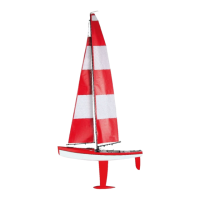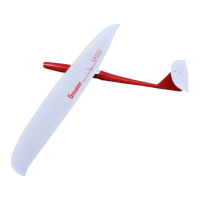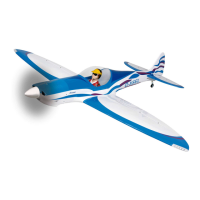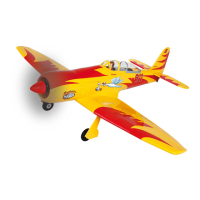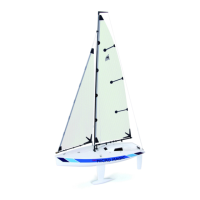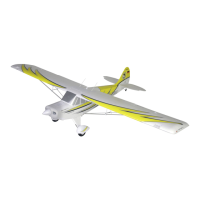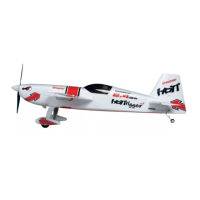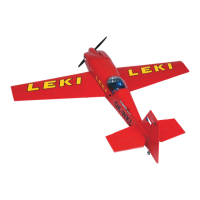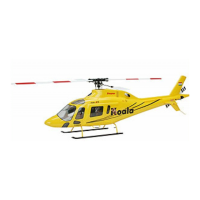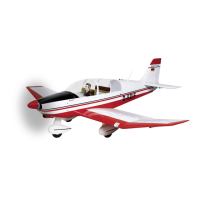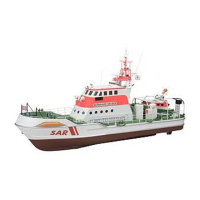9
to one half of one joiner, and push it into the outboard wing panel as far as the pencil mark. Apply a
thin coating of epoxy to the appropriate root rib of the centre section and the projecting end of the
dihedral brace. Apply plenty of epoxy to the inside of the joiner slot in the centre section.
Slide the centre section onto the joiner, and push it up against the root rib of the outboard panel.
Check that the two panels are not twisted relative to each other. The root ribs must meet snugly,
without gaps. Glue the left-hand outboard panel to the centre section in the same way. Where epoxy is
forced out of the joint, wipe off the excess using a piece of kitchen paper dipped in methylated spirit
(“meths”).
Tape the wing panels together to prevent them shifting out of alignment, then leave the wing
joints to harden completely. It is important to set the wings at the correct dihedral. This is done
by packing up each wingtip to a height of about 35 mm. Apply tape over the trailing edge joints to
avoid them slipping out of alignment.
When the epoxy has cured, carefully remove the strips of tape. Caution: peel the tape off slowly,
doubling it back onto itself, otherwise there is a danger of pulling off the covering film at the same time.
Installing the aileron servos
Fit the rubber grommets and tubular rivets into the mounting lugs of the aileron servos, as described
for the retract servo.
Set the aileron servos to centre from the transmitter, i.e. connect the servos and receiver battery (plus
switch harness) to the receiver; switch on the transmitter and receiver and set the associated trim
levers to centre.
The servos are now at their neutral setting.
Drill 1.5 mm Ø pilot-holes in the mounting blocks, and fix the servos to the blocks using the screws
supplied with them. The tubular spacers can be used as a template when you are drilling the holes.
Place the servo well hatch covers (with servos attached) in the wing recesses. Drill pilot-holes for the
four retaining screws, and screw the covers to the wing as shown. Temporarily fix the ailerons at the
neutral position by applying tape over the aileron and the fixed trailing edge of the centre section. Cut
down the three-point aileron horns so that the distance between horn base and clevis linkage point is
20 mm. Position the horns on the ailerons in such a way that the pushrods run exactly parallel to the
servos. The linkage holes in the aileron horns must line up correctly with the aileron hinge pivot line.
Drill holes in the ailerons for the horn retaining screws. Fix the horns to the ailerons using M2 x 20
pan-head screws and plastic spreader plates. When you have screwed the horns to the ailerons, snip
off the excess screw length at the spreader plates and file the screws back flush with the plates.
Each pushrod consists of a length of M2 threaded rod, an M2.5 clevis and an M2 clevis.
Screw an M2 locknut and an M2 clevis onto the M2 threaded rod, and connect the clevis to the servo
output arm. Connect the M2.5 clevis to the horn, check that the aileron and servo are both at neutral
(centre), then mark the correct length of the pushrod. Cut the pushrod to length and solder it into the
M2.5 clevis. Cover the wing surface with a piece of card to protect the covering film from blobs of
excess solder.
Gluing the tailplane and fin to the fuselage
Use a soldering iron to remove the covering film over the slots for the fin and tailplane in the tail end of
the fuselage; please take care not to set the soldering iron to an excessive temperature; it should be
just hot enough to melt the film.
Locate the slots under the film with your fingertips, and mark them with a felt-tip pen. Push the tip of
the soldering iron through the film and run it along the edges of the slot until all the film is melted away.
Use the same procedure to open up the slots for the rudder and elevator pushrods. Note that there are
two slots for the elevator pushrods - one on each side of the fuselage.
Slide the tailplane and fin into their slots. Adjust the position of the tailplane until it projects by exactly
the same length on both sides, and is at right-angles to the fuselage centreline when viewed from
above. Mark the outside shape of the fuselage on the tail panels using a felt-tip pen.
Melt the covering film along the marked lines by running a soldering iron lightly along a steel ruler.
Keep slightly inside the lines, and peel the film away from the wood.
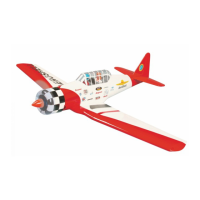
